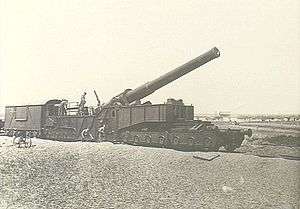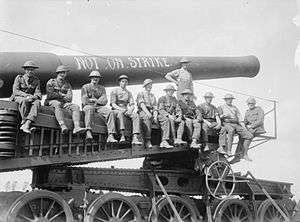BL 12-inch railway gun
The British Ordnance BL 12 inch gun Mk IX on truck, railway mounted surplus 12 inch Mk IX W naval guns, manufactured by Woolwich Arsenal in 1906,[2] on various railway platforms to provide mobile long-range heavy artillery for the British Army on the Western Front in World War I.
| Ordnance BL 12 inch Gun Mk IX on truck, railway | |
|---|---|
 12 inch Mk IX W railway gun on Armstrong Mk II mounting, Méaulte, France 1916 | |
| Type | Railway gun |
| Place of origin | United Kingdom |
| Service history | |
| In service | 1915 - 1930 (Rail) |
| Used by | United Kingdom |
| Wars | First World War |
| Production history | |
| Manufacturer | Woolwich Arsenal (guns) Vickers & Elswick Ordnance Company (carriage) |
| Produced | 1906 (guns) |
| No. built | 4 (Rail) |
| Variants | mountings Mk I, Mk II |
| Specifications | |
| Barrel length | Bore: 40 ft (12.192 m) L/40 |
| Shell | HE; 850 lb (385.55 kg) |
| Calibre | 12-inch (304.8 mm) |
| Breech | Welin screw |
| Recoil | Hydro - spring, 34 inches (863.6 mm)[1] |
| Carriage | Railway truck |
| Elevation | 0° - 30°[1] |
| Traverse | 1° L & R[1] |
| Muzzle velocity | 2,610 ft/s (796 m/s)[1] |
| Maximum firing range | 32,700 yards (29,900 m)[1] |
| Filling | Amatol |
| Filling weight | 94 lb (42.64 kg) |
History
Vickers mounted two Mk IX W guns on slightly different railway mountings, Mk I, from September 1915. They are both identified by the open-frame appearance, recoil buffers above the barrel and the bogies with frames between the wheels similar to locomotive bogies. One mounting has a distinctive diamond-shape from the side and has a warping winch on the front; the other's carriage has a more squared-off profile with no warping winch at the front. The weapons on the Mk I mountings were originally reserve guns for HMS Cornwallis.[3]
Elswick Ordnance Company (Armstrongs) mounted two more on its own design of Mk II railway mounting, delivered to the Western Front in August 1916. They are identified by the boxed-in frame appearance, recoil buffers below the barrel and the bogies with frames outside the wheels.
Design
The gun cars allowed only 1° left and right traverse, achieved by pivoting the entire gun car body about the forward bogies, in the two Vickers carriages, or about the rear bogies in the Armstrong carriages. Like most railway guns in the war it was operated on specially-constructed curved sections of track and moved forward or backward to point it at a new target. Fine adjustment could then be achieved by onboard traversing, which at the gun's maximum range covered an arc of about 1,000 yards.[4]
The initial shock of firing was absorbed by a hydro-spring mechanism, allowing 34 inches of recoil within the gun mounting. The remaining recoil energy was absorbed by allowing the entire railway wagon to roll backwards 40 feet[5] (Vickers carriage) or 3-4 yards[6] (Armstrong carriage) against locked brakes. This "rolling recoil" system allowed the gun to be operated without the need to construct a pit with a strong static platform below the gun for it to recoil into and to allow transmission of all the recoil force directly to the ground as was typical of many large US and French railway guns.
Combat service

At the end of World War I, the dispositions of the guns on the Western Front were: 1 gun of 92 Battery and 1 gun of 543 Battery with First Army i.e. Artois; 1 gun of 92 Battery with Third Army i.e. Somme; 1 gun of 543 Battery with Fourth Army i.e. Somme.[7]
See also
- List of railway artillery
- BL 12 inch Mk IX naval gun
Weapons of comparable role, performance and era
- Canon de 305 mm Modèle 1893/96 gun French equivalent railway gun
Notes and references
- Hogg & Thurston 1972, Page 193
- Hogg & Thurston 1972, Page 192. Two of the guns may have been manufactured during World War I, as 'British 12"/40 (30.5 cm) Mark IX' states that 6 more Mk IX W guns were made during World War I.
- Hogg 1998, pp. 118-122
- Miller 1921, page 154
- Miller 1292, page 149
- Miller 1921, page 155
- Farndale 1986
Bibliography
- Dale Clarke, British Artillery 1914-1919. Heavy Artillery. Osprey Publishing, Oxford UK, 2005
- General Sir Martin Farndale, History of the Royal Regiment of Artillery. Western Front 1914-18. Oxford: Royal Artillery Society, 1986. ISBN 1-870114-00-0
- I.V. Hogg & L.F. Thurston, British Artillery Guns & Ammunition 1914-1918. London: Ian Allan, 1972.
- Hogg, Ian V. (1998). Allied Artillery of World War I. Ramsbury, Wiltshire, UK: The Crowood Press, Ltd. ISBN 1-86126-104-7.
- Harry W Miller, United States Army Ordnance Department. Railway Artillery: A Report on the Characteristics, Scope of Utility, Etc., of Railway Artillery, Volume II, Pages 146-155. Washington : Government Print Office, 1921